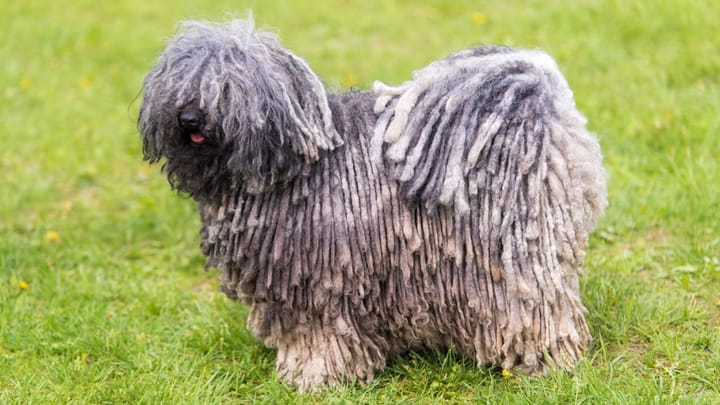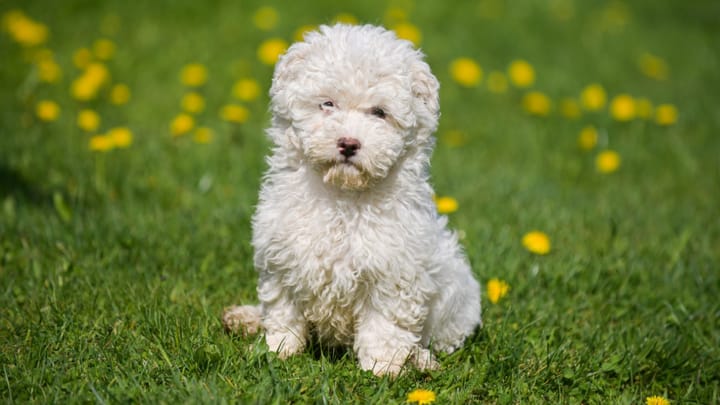Puli
Other name: Hungarian Puli


The Puli is a medium-sized dog that was originally bred in Hungary and was used for herding livestock. It is recognised most readily by its long and corded coat. The ‘dreadlock’ appearance of the dog’s coat is shared only with the Puli’s larger cousin the Komondor. The Puli is an agile, intelligent and loving dog but one that is prone to stubbornness and independence. The word used for a gathering of two or more of these dogs is ‘Pulik’.
|
Life expectancy |
The Puli has a life expectancy of between 13 and 15 years |
|
Temperament |
|
|
Size |
Medium
|
|
Adult size |
Female
Between 14 and 17 in
Male
Between 15 and 18 in
|
|
Adult weight |
Female
Between 22 and 29 lb
Male
Between 29 and 33 lb
|
|
Coat colour
A Puli’s coat can be coloured completely black or black with some areas of grey. Other less common coat colours are white, grey or fawn. Fawn-coloured Pulik often have black faces; this gives us an impression of them wearing a mask. |
Black White Blue |
|
Type of coat
Their hair is long. The Puli’s coat is usually corded or curled but can vary slightly in appearance from dog to dog determined by the nature of the undercoat and texture of the top coat. Some Puli coats are self-cording but most are corded by the dog’s owner. The Puli’s coat takes around four years to fully develop. |
Long Wavy |
|
Eye colour
The Puli’s eyes are usually coloured dark brown. |
Brown
|
|
Purchase price |
The Puli costs between £560 and £740 |
Although the Puli’s coat is arguably the dog’s best-loved feature it does have its drawbacks. The dog is especially intolerant to heat and great care must be taken to avoid the Puli overheating. Additionally, the coat will weigh very heavily on a swimming dog. Care should be taken to assist a Puli from the water if the owner believes the dog is getting tired.
More details about the Puli
Puli: Origins and history
Pulik are an ancient breed of dog known to have been used by Hungarian farmers of the Middle Ages. They were introduced to Hungary by nomadic Asian tribes and so are believed to have first been used by farmers of the Middle East and India. Pulik with light-coloured coats were set among herds of sheep in an attempt to protect the animals from poachers and wild animals. The popularity of the breed as a house dog in the United Kingdom waned after World War II and has not surged since.
Physical characteristics of the Puli
The Puli has a sturdy and well-balanced look. The thickness of the fur belies the lean but muscular body. The top line of the dog appears almost horizontal. The dog’s long tail curls flatly over its croup. Despite its sturdy appearance the dog’s skull is usually small and fine and its muzzle short. The ears are reasonably high on the dog’s head and hang close; they widen at the base.
FCI classification of the Puli
-
Group 1 - Sheepdogs and Cattledogs (except Swiss Cattledogs)
-
Section 1 : Sheepdogs
Puli: Characteristics
Puli: Behaviour
Training a Puli
The Puli is a strong-willed animal and one that is not easily trained. Being independent the Puli will learn when it wants to learn. An owner’s half-hearted efforts won’t make much difference. The Puli requires an even stronger-willed leader who is confident and consistent. Do not berate a Puli; this is a proud dog yet sensitive and any harshness of language or actions will only make the job of training harder.
Puli: Lifestyle
Breed compatibility Puli
Puli: Purchase price
Puli costs between £560 and £740.
To care for a Puli, you should count a budget between £60 to £100 per month.
Puli: Shedding
Light
The Puli coat is considered to be non-shedding and hypoallergenic.
Puli: Grooming
The uncorded Puli coat should be brushed regularly to prevent its hair from becoming tangled and matted. The corded coat must be groomed by more delicate means: dampen the coat with water and then separate the cords and curls of the coat by hand. You may want to bath your Puli from time to time because its coat collects foreign matter from the outdoors. The Puli is usually trimmed in the spring in readiness for the summer.
Puli: Health
13 to 15 years.
A Puli outdoors will not care what the weather is like. This particular breed of sheepdog is one of the hardiest. The agility and strength of the Puli prevent it from injuring itself.
The Puli does not tolerate hot weather at all. A four to six inch trim in the springtime is recommended in readiness for the summer heat.
The double coat of the Puli keeps the dog warm even when walking in the rain and snow. Dry a Puli off after a particularly wet walk (it can take up to 12 hours for the Puli’s coat to completely dry).
Weight gain can be a feature of the Puli. If your Puli is not exercised as regularly as it should be and is fed too much human or substandard food it will become obese.
- Bardet Biedl Syndrome
- Cataracts
- Degenerative Myelopathy
- Mammary neoplasia
- Primary Lens Luxation





